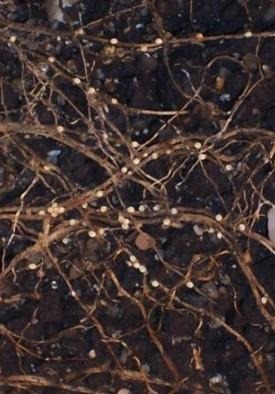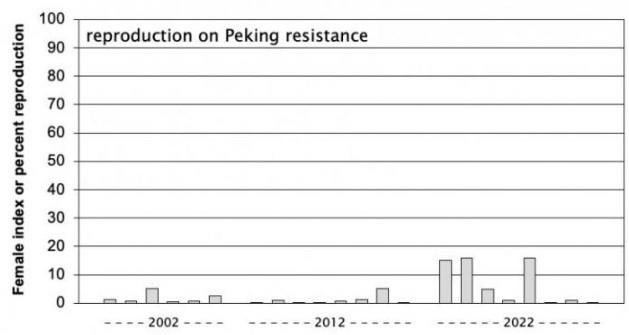
Soybean cyst nematode females on roots
A standard way to assess potential control of an SCN population with resistance is a greenhouse test that measures reproduction of a nematode population on a resistant soybean breeding line compared to on a susceptible (non-resistant) variety. The test results are expressed as female indices, which are percentages. If female indices are below 10% on a resistant breeding line, the resistance will be effective when used in soybean varieties to be grown by farmers.
Troubling trend for Iowa
Every Iowa SCN population tested in the 1990s had female indices below 10% on all of the soybean breeding lines for SCN resistance. That means that soybean varieties with any source of resistance genes provided effective control back then.
In 2002, results of these greenhouse tests revealed SCN populations with female indices greater than 10% on PI 88788 (Figure 1, top). Similar increased levels of SCN reproduction were not seen on Peking (Figure 1, bottom).
Levels of reproduction on PI 88788 among Iowa SCN populations have increased steadily over the last two decades (Figure 1, top). These results show that Iowa SCN populations are adapting to PI 88788 resistance and the resistance is considerably less effective now compared to when it was introduced in the early 1990s.
Record high reproduction on PI 88788 SCN resistance in 2022
In 2022, the female indices of SCN populations on PI 88788 in three fields used for research were 75% to 90%. In three other fields the female indices of SCN populations were 50% to 68% on PI 88788, and two were 22% and 33% on PI 88788 (Figure 1, top). We have never seen an SCN population in Iowa with a female index of more than 70%. Considering how widespread SCN is in Iowa, these results are frightening.
Figure 1. Reproduction of SCN populations from farmers’ fields on PI 88788 (top) and Peking (bottom) resistance breeding lines in 2002, 2012, and 2022.


Back to the 1980s
An SCN population with a female index of 90% on PI 88788 means that the source of resistance and any varieties developed with the breeding line will provide 10% control of the nematode at best. This high level of reproduction makes the complete loss of effectiveness of PI 88788 SCN resistance seem possible within several years. Having no effective resistance against SCN hasn't occurred in Iowa since the 1980s, before SCN-resistant varieties were available.
Note, also, that these SCN populations with very high levels of reproduction on PI 88788 resistance are not spreading from field to field in Iowa, they are developing within the fields because of continual use of a single set of resistance genes.
More varieties with Peking and other SCN resistance are needed
Soybean varieties with the effective Peking resistance remain a small proportion of all available SCN-resistant varieties. And while the number of soybean varieties with Peking SCN resistance is increasing every year, the rate of increase is not keeping pace with the increase of SCN reproduction on PI 88788 resistance.
SCN management for now
Using an active, integrated approach to managing SCN in Iowa is more important than ever. Management of SCN should involve:
1) rotating nonhost corn with soybeans in fields infested with SCN;
2) growing high-yielding soybean varieties with PI 88788 resistance that provide as much SCN control as possible (see www.isuscntrials.info for information on resistant varieties);
3) rotating PI 88788 SCN-resistant varieties with Peking resistance, if possible, even for just one season; and
4) assessing nematode-protectant seed treatments in fields to identify those that provide added protection against SCN.
Source : iastate.edu